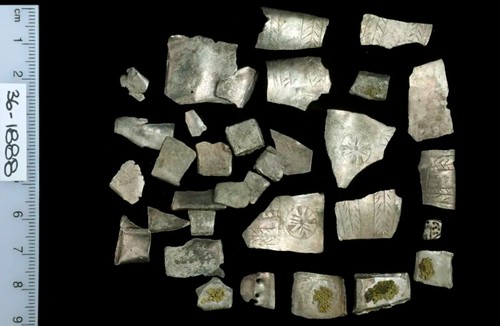
PREV ARTICLE
NEXT ARTICLE
FULL ISSUE
PREV FULL ISSUE
A NEW STUDY ON ANCIENT COUNTERFEITINGArthur Shippee and Howard Berlin passed along this Jerusalem Post story about a new study on ancient counterfeiting. Thanks. -Editor

Ancient counterfeiting is the subject of a new joint study by the University of Haifa and the Hebrew University of Jerusalem that will be published in the upcoming issue of the Journal of Archaeological Science. The study found evidence of a severe shortage of silver in the Levant during the first Iron Age (between 1200-950 BCE), the period when the tribes of Israel settled in Canaan, which led to the creation of silver made with a high percentage of copper. "The small percentage of silver in the pieces of silver, which were mixed with other substances such as arsenic that made them appear silver in color... reinforces the hypothesis that at least for part of the period, it was a deliberate forgery," the researchers said. According to the researchers, at that time no coins had yet been minted, and trading was done using silver pieces that were not uniform, so the amount of silver in each piece was important. As part of Eshel's doctoral dissertation and other previous studies, it has been established that silver earrings from the area from earlier periods (starting from 1900 BCE) were made of almost 100% silver, as were those from later periods. However, when the researchers examined the chemical composition of these Iron Age caches, they found that they were made of an alloy composed mainly of copper, with the copper content as high as 80% in certain pieces. The researchers also found that substances such as arsenic were also added to these alloys, in order to give the ingot a silver color. While the researchers said there was no conclusive evidence that this was a forgery, they feel that there was a deliberate attempt to simulate the silver color of these metal pieces. "In addition to the fact that there was a deliberate attempt to paint the metal silver, we found that in the ancient caches the percentage of copper was higher and the amounts of arsenic were very similar from piece to piece," they wrote. Eshel writes that: "In the book of Ezekiel in Chapter 22, the prophet prophesies that he is angry with God over the children of Israel and says: ‘Son of man, the people of Israel have become dross to me; all of them are the copper, tin, iron and lead left inside a furnace.' "The sentence itself is of course a metaphor for the relationship between God and the children of Israel," she concludes. "But in practice, it is quite possible that it describes a reality that was familiar at the time: A silver ingot was mixed with various metals such as tin, iron and ore."
To read the complete article, see:
Paul Horner passed along this related article from the Times of Israel. Thanks. -Editor
To read the complete article, see:

Wayne Homren, Editor The Numismatic Bibliomania Society is a non-profit organization promoting numismatic literature. See our web site at coinbooks.org. To submit items for publication in The E-Sylum, write to the Editor at this address: whomren@gmail.com To subscribe go to: https://my.binhost.com/lists/listinfo/esylum All Rights Reserved. NBS Home Page Contact the NBS webmaster 
|